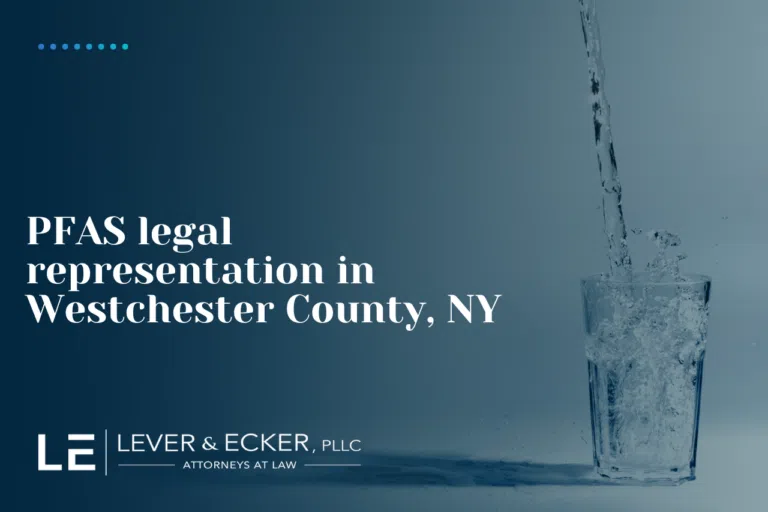PFAS (per- and polyfluoroalkyl substances) have become a growing concern for public health and the environment due to their persistence in both. These chemicals, often referred to as “forever chemicals,” have been linked to serious health risks and widespread contamination. As more people become aware of their dangers, PFAS lawsuits are gaining traction, as individuals and communities seek justice for the harm caused by exposure. In this blog, we’ll explore the emerging lawsuits around PFAS, their effects on the body, and who could be held liable for contamination. If you believe you or a loved one has been harmed by PFAS, contact our Westchester county personal injury lawyers to schedule a free consultation.
What are the Emerging Lawsuits Around PFAS?
In recent years, PFAS lawsuits have surged as more communities and individuals discover that they have been exposed to these harmful chemicals. Lawsuits typically involve claims against manufacturers, industries, and municipalities for contamination of drinking water, soil, and air. These cases can take many forms, from individual lawsuits to large-scale class actions.
For example, numerous lawsuits have been filed against companies that have used PFAS in their manufacturing processes, such as those in the textile, cookware, and firefighting foam industries. Communities near military bases, airports, or industrial plants that used these chemicals have also been severely impacted, leading to legal action for environmental cleanup and compensation for health-related damages.
As the science around PFAS exposure grows, so too does the number of cases. Courts are increasingly being asked to consider the long-term consequences of exposure and whether companies are liable for the resulting harm.
What Are Forever Chemicals?
PFAS are a class of man-made chemicals used since the 1940s in a wide variety of industrial and consumer products. They have gained the nickname “forever chemicals” because of their extreme resistance to breaking down in the environment and the human body. This persistence means that PFAS can remain in the environment for decades, or even longer, without degrading.
These chemicals are commonly found in items like nonstick cookware (Teflon), waterproof clothing, food packaging, and firefighting foam. They are prized for their ability to repel water, grease, and stains, but this very durability makes them hazardous, as they accumulate in water supplies, soil, and wildlife.
How Does PFAS Get into Your Body? How Long Do They Last?
PFAS can enter your body through various routes, primarily through contaminated drinking water, food, or air. Since these chemicals are not easily broken down, they accumulate over time, leading to higher levels of exposure. People who live near industrial sites, airports, or military bases may be at higher risk due to the proximity to contamination sources.
Once in the body, PFAS are absorbed into the bloodstream and can persist for years. Studies have shown that the half-life of some PFAS can range from several years to over a decade, meaning they remain in the body for a long time. This prolonged exposure increases the likelihood of harmful effects, especially with repeated exposure over many years.
What Is the Effect of PFAS on the Human Body?
The health effects of PFAS exposure have been a significant concern for researchers and health professionals alike. Some of the known health risks associated with long-term PFAS exposure include:
- Cancer: Certain types of PFAS, such as PFOA and PFOS, have been linked to kidney and testicular cancer.
- Immune System Dysfunction: PFAS can weaken the immune system, making individuals more susceptible to infections and reducing vaccine effectiveness.
- Hormonal Disruption: These chemicals can interfere with the endocrine system, leading to problems such as thyroid dysfunction and developmental delays in children.
- Liver Damage: PFAS exposure has been linked to liver damage and an increased risk of fatty liver disease.
- Cholesterol Elevation: Studies have found that people exposed to PFAS often experience increased cholesterol levels, a risk factor for heart disease.
Given their wide-reaching impact on human health, many individuals exposed to PFAS are pursuing legal action to seek compensation for the damages they’ve suffered.
Who Could Be Held Liable for PFAS Contamination?
Several parties may be held liable for PFAS contamination, depending on the circumstances of the case. These include:
- Manufacturers and Corporations: Companies that produce or use PFAS in their products may be held responsible for contamination caused by improper disposal or failure to warn the public about the dangers of exposure.
- Local and State Governments: If public water supplies are contaminated with PFAS, municipalities and local governments may be held liable for failing to prevent the contamination or to provide safe drinking water.
- Federal Agencies: In some cases, the federal government, including agencies like the U.S. Department of Defense (which has used PFAS in firefighting foam), may also be responsible for contamination on military bases or other federal properties.
- Landowners and Employers: Property owners and employers who allow PFAS to seep into the environment from their properties or workplaces may face legal consequences.
Holding these parties accountable is crucial for compensating affected individuals and funding necessary environmental cleanup efforts.
Contact Lever & Ecker for a Case Review
If you or someone you know has been exposed to PFAS and suffered health consequences, you may have a legal claim. At Lever & Ecker, PLLC, we are dedicated to helping individuals who have been harmed by toxic chemicals like PFAS. Our team of experienced attorneys can review the details of your case, advise you on your legal options, and help you seek justice.
We understand the complexities of PFAS litigation and are here to guide you through every step of the legal process. Contact us today for a case review and to learn more about how we can help you pursue compensation for your damages.


